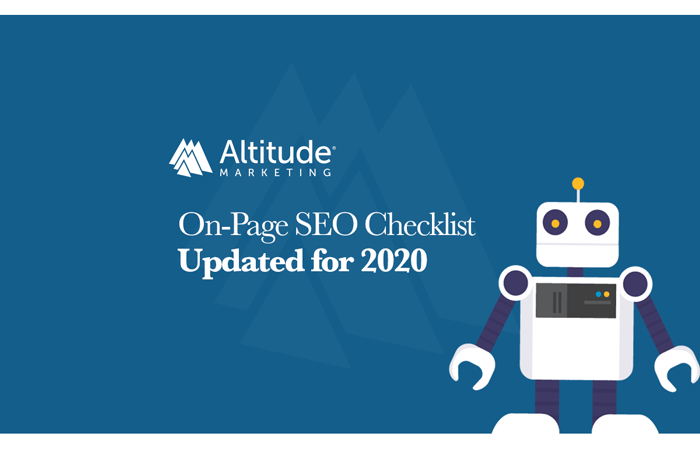It’s been nearly seven years since we first published this on-page SEO checklist. Since then it’s helped more than 30,000 marketers learn search engine optimization best practices.
Of course, a ton has changed since 2013. The tactics needed to increase organic traffic, driving leads and improving position in search engine rankings are very different. As a result, we’ve updated our on-page SEO checklist for 2020 – and beyond.
Competing for top rankings in the search engines involves three elements:
- On-page – Optimizing and improving what is on your website pages
- Off-page – Measuring and improving things are that are happening beyond your site, such as the number and quality of links coming into your site from other sites
- Technical factors
In this post, I’ll focus on No. 1 above – on-page optimization. It’s a huge factor in Google’s search algorithm, so it’s critical to any SEO 101 discussion.
On-Page SEO = Content + HTML
The content on your site and the HTML behind your website pages are among the most accessible and controllable search engine optimization elements. That means they are a great starting point for your SEO efforts.
Your goal is to make every page on your site search-engine-friendly, with content and tools ready to further your business goals. (This SEO checklist breaks down everything you need to know.)
The biggest thing to keep in mind is that perfectly optimized pages are also perfect for users. By all means, don’t “do SEO.” That’s really just trying to trick Google.
Instead, focus on a topic and create the best possible page or post about it. That’s the content that wins in the end.
The best page in the world about one topic can’t also be about another topic.
For optimization purposes, you should have one, or at most, two target keywords or phrases in mind per page. If you are trying to rank well for three or four keywords on a single page, it’s time to step back and consider breaking up the content onto several different pages so you can create page focus.
The best page in the world about one topic can’t also be about another topic.
Establishing an SEO Baseline
Now is the time to get a good idea for where your site ranks on your desired terms. You can do this using tools like SpyFu and Google Search Console.
If a page or post is already on Page 1 of Google search for your chosen term(s), leave it alone. Of course, you should make occasional updates to keep its content and/or resources updated and relevant to site visitors.
Once you know the pages you want to optimize, it’s time to run through this on-page SEO checklist.
No single factor on the checklist is make-or-break for getting your page to rank well, but they work in combination to raise your overall score. Google looks at more than 200 factors when ranks a page. But the whole is greater than the sum of the parts. Again, the key to a perfectly optimized page is that it provides the best possible content on a topic.
What Is the Best Possible Content?
Think about a topic. Any topic.
If you wanted to learn more about something, what would you want?
Well, you’d want website content that is comprehensive, and obviously written by an expert.
You’d want it to be obvious that you’re in the right place.
Illustrations or graphics would help.
The content would be relevant to your geography and culture.
And it would be free of grammar mistakes and typos. In other words, it would be trustworthy.
Here, we’re hitting on the concept of E-A-T. That stands for:
- Expertise
- Authority
- Trustworthniess
E-A-T is the core of what Google looks for in 2020. In fact, it’s the main topic of the 168-page guidelines that Google distributes to its search quality raters.
Basically, prove your expertise on a topic, your authority to talk about it and your trustworthiness. Sure, keyword density and that stuff matters. A little. But if you answer a question perfectly, you’ll rank first.
Keep that in mind when you go through this on-page SEO checklist.
 Perfectly Optimized On-Page SEO Checklist
Perfectly Optimized On-Page SEO Checklist
- Content is high-quality, relevant, fresh and at least 500 words in length. Longer is better.
- Target search phrase is included in page headline.
- Target search phrase is included in at least one sub-headline.
- Target search phrase is repeated three to 10 times within body copy. Don’t over-do it, or the page may get downgraded as spam.
- Keep the reader in mind as you work with the target search phrase. Copy should always be reader-friendly.
- Page includes relevant images and/or graphics that help illustrate the target search phrase.
- Captions for images and/or graphics include the target search phrase.
- Content and/or tools and resources on the page are so good that visitors will want to share your link with others and post your link elsewhere.
- Location: If you are optimizing for specific country, state, city or regional names, be sure they are in your copy and perhaps in a page footer.
- No misspellings or poor grammar. Yes, the search engines downgrade for either.
- Inclusion of social media links and/or user discussion or reviews. Pages with active visitor interaction are scored higher than static pages.
Coding and Behind-the-Scenes SEO Factors
- Include the target keyword/search phrase in the page URL if possible.
- Title tag: Every page should have an HTML title (enclosed in <title> </title> tags). The title copy should be unique, include the target keyword or target phrase, and must be 70 characters or less (any longer, and Google will truncate it anyway).
- Meta description tag: Even if the search engines don’t weigh a meta description in ranking a page, it is very important, because it is the marketing copy for your page. The meta description in the page head-tag set (enclosed in <meta name = “description” content=””> usually appears with your organic search listing, and induces readers to click through. The meta description tag should be no longer than 160 characters, and should include your target phrase.
- Image alt text: Use the target phrase in image alt text (embedded in the image tag as alt=”your keyword”). Don’t spam in alt text – if an image is purely descriptive, describe it as such.
- Links from copy: Use links to other pages on your site, or other resources judiciously. Links should be relevant to your page topic. Research shows Google may penalize any page containing more than 100 links, and we recommend stopping well short of that number, unless there is a good reason. A few internal links (to other pages on your site) are a positive, especially if they tie together similar topics. Internal links also help search engine bots navigate and categorize your site.
- Mobile: Mobile-first indexing is a thing. That means Google actually only sees the mobile version of your site. (This happened around 2019.) Make your page fantastic on a smartphone, even if most of your traffic comes from desktops. (AMP is the ideal.)
Following this on-page SEO checklist will result in a page that’s optimized for ranking well in search. It provides a foundation for other organic search improvement efforts. Back it with solid E-A-T and you can’t lose.
Additional major factors, such as the authority of your site’s domain, and the number and authority of links coming into your page and your site will also play a big role in search ranking, which I address in other articles.
While you can tackle many elements of the perfectly optimized page on your own (they should become part of your team’s SOPs), you will find that professional help with keyword research, competitive research, content creation, page design, setup, and coding will dramatically accelerate the process.

 Perfectly Optimized On-Page SEO Checklist
Perfectly Optimized On-Page SEO Checklist

